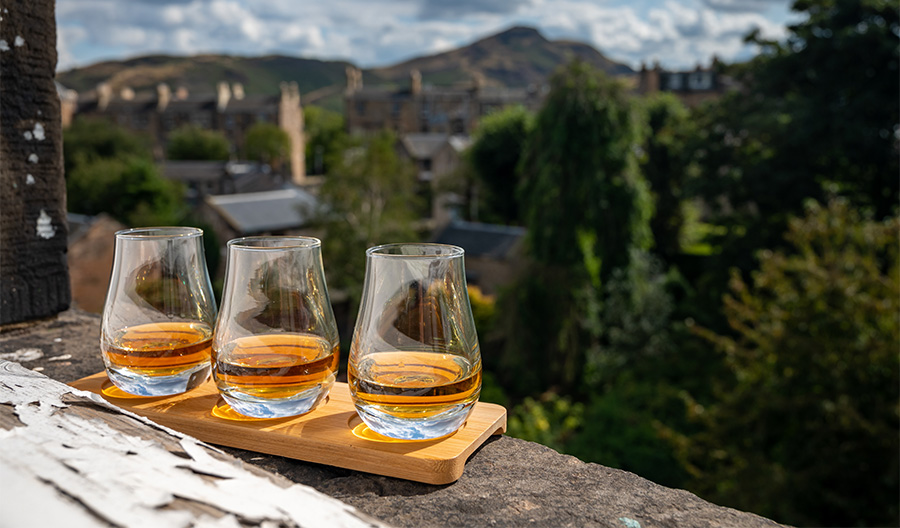From Spanish Sherries to Douro Valley Ports, fortified wines vary in color, flavor, origin, and sweetness. But all have one thing in common: fortification.
Fortification, the addition of grape spirit to wine either during or after fermentation, is a technique used to increase alcohol content and stop fermentation. The process was popularized by the English in the late 17th century to stabilize and preserve wines for long sea voyages. Prior to the development of fortification, many of these wines were made originally as still, unfortified wines.
However, many decisions, like at what point during fermentation a wine is fortified and how it’s matured, create a diverse array of bottlings.
All Sherry hails from hot, dry southern Spain, centered in the towns of Jerez de la Frontera, Sanlúcar de Barrameda and El Puerto de Santa María.
While the low-acid, white Palomino grape dominates the region, it’s often supplemented by aromatic Moscatel (also known as Muscat of Alexandria) and robust Pedro Ximénez. In general, fermentation takes place in neutral stainless-steel tanks, followed by extended aging in neutral barrels.
Because Palomino is such a neutral grape, the aging process is crucial to the style of the finished wine. Sherry wines are aged in rows of barrels called criaderas using the solera system, whereby fresh wine is added to barrels holding multiple back years of wine, thus leading to many vintages being blended over time.
The process works like this: Winemakers take a percentage of wine from the oldest section below of a solera for bottling. Next, they top up the solera with wine from the first criadera (the next-oldest section), and then they fill the first criadera with wine from the second criadera, and so forth. Each style of Sherry has its own solera system within a bodega, some of which may be decades old.
There are various styles of Sherry, but dry Sherries can be classified largely into two categories: those aged under a veil of yeast called flor, which includes fino and Manzanilla, and ones matured with oxygen contact, like oloroso. Some, like amontillado and Palo Cortado, are “hybrid” styles that undergo both aging techniques.
Generally, free-run and first-press juice is used for fino and Palo Cortado, while second-press juice is used for oloroso.
“Free-run and first-press must generally has a more elegant, soft and neutral character,” says Antonio Flores, winemaker and master blender for González Byass. “This allows the flor to leave a dominant yeast character. For the oloroso style, we are looking for a must with more structure, body and complexity.”
Flor-aged Sherries are fortified with a grape spirit until the wine reaches between 15% and 15.5% abv. This encourages flor to grow, which protects the wine from oxygen and imbues it with almond-like, yeasty notes and a dry, refreshing texture.
Sherries aged through oxidation are fortified to about 17% abv. Since flor cannot survive at those levels, oxygen can interact with the wine. This creates nutty, caramel-like notes and develops a round, viscous texture.
After a few months in barrel, the wines are assessed and can be reclassified. If a wine is too robust and hasn’t developed a strong layer of flor, it may be fortified again to 17% abv and aged as amontillado or slightly richer Palo Cortado solera systems. Both of these styles of wine have fresh, citrusy qualities and nutty, oxidative aging characteristics.
Sweet Sherries are the result of different winemaking decisions, though they’re also aged in solera. Naturally sweet Sherry like Pedro Ximénez and Moscatel are made from super-concentrated, dried grapes with sugar levels so high that fermentation doesn’t finish before the alcohol is added. They’re fortified to 15 or 16% abv.
Pale Cream and Cream Sherries are usually fermented until dry, then fortified and sweetened.


Port is always a sweet, fortified wine made from grapes grown on the steep slopes of Portugal’s Douro Valley. The warm, dry conditions make powerful, ripe red wines, though white grapes are grown as well.
Unlike Sherry, Port is often the result of a blend of multiple grape varieties, often from different vineyard sites. The most prominent ones used to make Port include Touriga Nacional, Touriga Franca, Tinta Barroca, Tinto Cão and Tinta Roriz.
Fortification with a 77% abv grape spirit takes place before fermentation is complete. This is why Port is always sweet, though the exact level of sweetness depends on a house’s style. The quality and flavor of the grape spirit that’s added also matters, since a fair amount needs to be blended in to achieve Port’s typical 19–22% abv.
In addition to white and rosé styles, Port can be split into two categories. Tawny Ports are aged with oxygen, while ruby Ports are aged for 2–3 years in wood, cement or stainless steel prior to bottling.
The first step for most Ports is barrel aging
“After a preliminary sorting at harvest time, the wines are put into wood,” says Symington. An exhaustive tasting is conducted the following spring to identify the wines that are structured and concentrated enough for vintage Port production.
The wines are then assessed to find those suitable for long aging in wood to create high-quality tawny Ports, where they will develop nutty, dried fruit notes. Others are determined best for bottling after a few years as fresh, fruit-forward late-bottled vintages or ruby reserve wines. The remaining wines are blended into basic ruby Ports.

